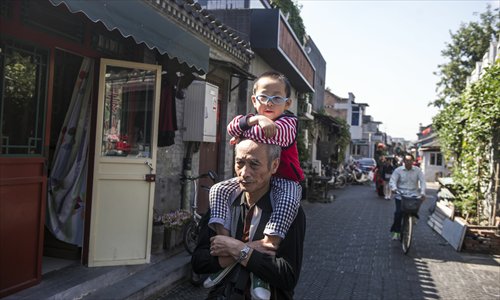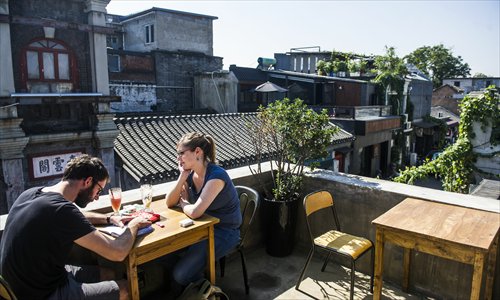

Local residents in one of the hutong in the old Dashilar neighborhood near Tiananmen Square. Photo: Li Hao/GT

Customers enjoying the afternoon sunshine on the terrace of one of Dashilar's recently refurbished cafes. Photo:Li Hao/GT
Can Beijing's designers revitalize old neighborhood without eradicating its past?
In a squalid hutong less than a kilometer from Tiananmen Square, among dingy convenience stores and derelict courtyard homes long since fallen into disrepair, is a chicly refurbished cafe-furniture shop.
This is by no means an uncommon sight in Beijing, where widespread gentrification has displaced countless poor and working class people of their homes and usurped their way of life. But take a closer look at this cafe-shop, and one notices some crucial differences.
The exterior facade of the two-storey concrete-and-brick structure still bears the hand-painted logo of its former identity - a factory that produced electrical relay devices. All of the furniture being sold is "upcycled" - objects discarded or considered waste that have been lovingly transformed. Inside, some of the produce that is served is sourced from their rooftop aquaponic farm, a process of food production that sustains its own mini-ecology so as not to produce waste.
The name of the hybrid space, Re-Up, neatly sums up its operating philosophy, as well as its broader attitude towards change in the historical Dashilar neighborhood where it is situated.
"Re-Up is a restoration project that is upcycle-conscious and sustainability-conscious. Re-Up means rejuvenating and reusing the materials we have," said Lin Lin, the British-Chinese designer and founder of the space.
Featured in this year's Beijing Design Week (September 26 - October 3), it can be seen as part of a wider, deliberate effort on the part of a small community of designers, architects and artists to revitalize the old Dashilar neighborhood without eradicating its past.
Restoration proclamation
In 2007, the nearby Qianmen Dajie was entirely demolished and reconstructed into something that has widely been criticized as a film set caricature of an ancient Chinese street. Although on the surface, it resembles a historical Chinese street, its actual history - the events that those old buildings had witnessed and the local residents who had witnessed them - have been displaced and erased.
For a time, it was feared that the Dashilar area would befall the same fate. A flourishing commercial hub that during the Qing Dynasty (1644-1911) boasted tea shops and stock exchanges, opera houses and brothels, the neighborhood had fallen into ruin and disrepair.
Due for a complete overhaul, a group of conscientious architects persuaded local developers to go in another direction.
In 2011, the organizers of the Beijing Design Week got involved, dedicating a number of their events to the space, in the hopes of finding an alternative way of reinvigorating the area. Projects like Re-Up have gradually taken root as a result of these initiatives.
These projects are aimed at preserving the integrity of the neighborhood. They seek to involve locals so they will be active participants in the process of change, rather than passive victims displaced from their homes.
Not only did Lin spend 11 months on redesigning and refurbishing the old factory space, but everything in the space is based on the principle of regeneration - from the old light bulbs (drinking glasses) to the chairs for patrons to sit on (converted rice container covers).
‘Mini 798‘ captures the imagination in Fangjia Hutong
2014-08-20Area guide: Fangjia Hutong, Beijing
2014-06-24Artist captures Beijing‘s hutong in ink
2014-05-21Copyright ©1999-2018
Chinanews.com. All rights reserved.
Reproduction in whole or in part without permission is prohibited.